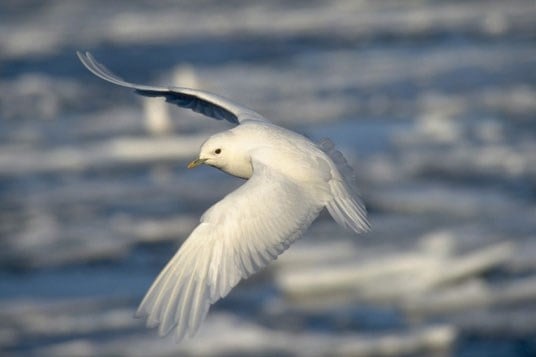Alarming decline in the ivory gull population
Historical archive
Published under: Stoltenberg's 2nd Government
Publisher: Ministry of the Environment
Press release | Date: 01/06/2007
New research shows an alarming decrease in the population of ivory gull in the Arctic. This is a conspicuous example of two main environmental challenges: climate change and hazardous chemicals.
New research shows an alarming decrease in the population of ivory gull in the Arctic. This is a conspicuous example of two main environmental challenges: climate change and hazardous chemicals.

The estimated population of ivory gull in 2006 is a third of the 1995 estimate. Photo: Bjørn Frantzen, Norwegian Polar Institute.
- The decline is very worrying. Changes in sea ice cover and high levels of hazardous chemicals are probably important causes. We are already observing a reduction of sea ice due to climate changes in the Arctic. This creates great problems for the ivory gull which lives by the ice edge, says Minister of Environment Helen Bjørnøy.
- We have to make an effort both nationally and internationally in order to stop emissions of hazardous chemicals and greenhouse gases. Norway has recently banned the chemical PFOS. Internationally Norway is a driving force behind efforts to ban mercury and other heavy metals, and will press for a more comprehensive and ambitious climate agreement to succeed the Kyoto Protocol. Norway will follow up its commitments and reduce emissions of greenhouse gases nationally as well as internationally, says Bjørnøy.
Ivory gull is a priority species in the bilateral environmental cooperation between Norway and Russia. Norwegian and Russian scientists conducted a joint assessment of the ivory gull population in the Barents Sea in 2006. Further studies are needed in order to assess the status of the ivory gull in the two countries, and the cooperation continues in 2007. The Ministry of the Environment has allocated 1.8 million Norwegian kroner to this project in 2006 and 2007, in order to ensure adequate knowledge of the ivory gull population.
The 2006 survey confirms the suspicion that there has been a significant decline in the ivory gull population. The estimated population in 2006 is a third of the 1995 estimate. Reduced sea ice cover, high levels of hazardous substances and illegal hunting are probably the main causes of the decline. Analyses of ivory gull eggs collected in Russia in 2006 show high levels of PCB and DDE.
Ivory gull is a rare species, and has been classified as an endangered species in the recent Norwegian Red List of Endangered Species. An estimated 80 per cent of the global population can be found in Russia and Svalbard.